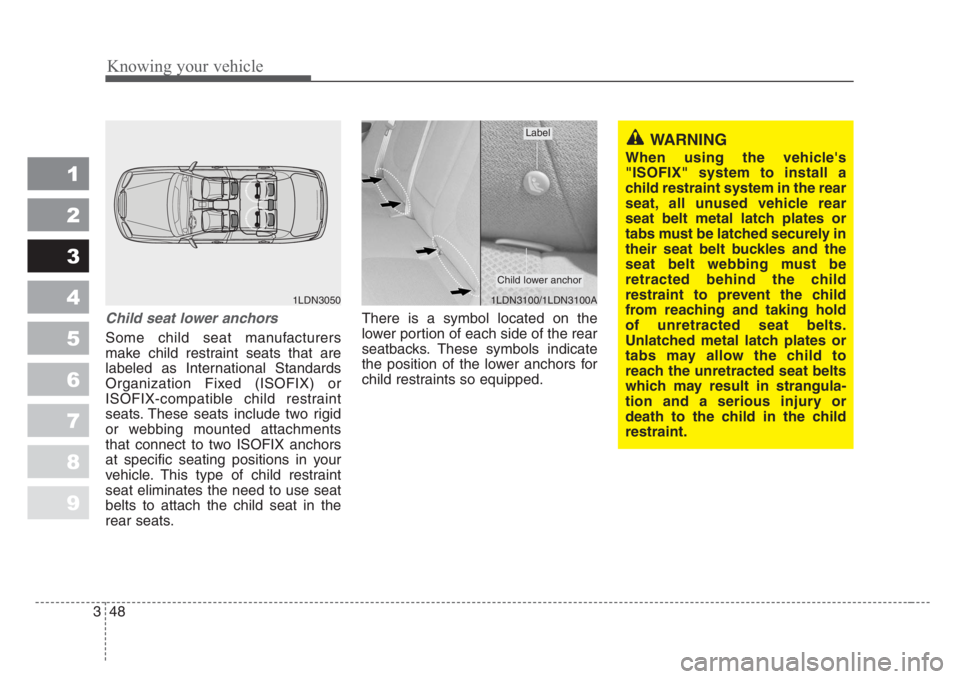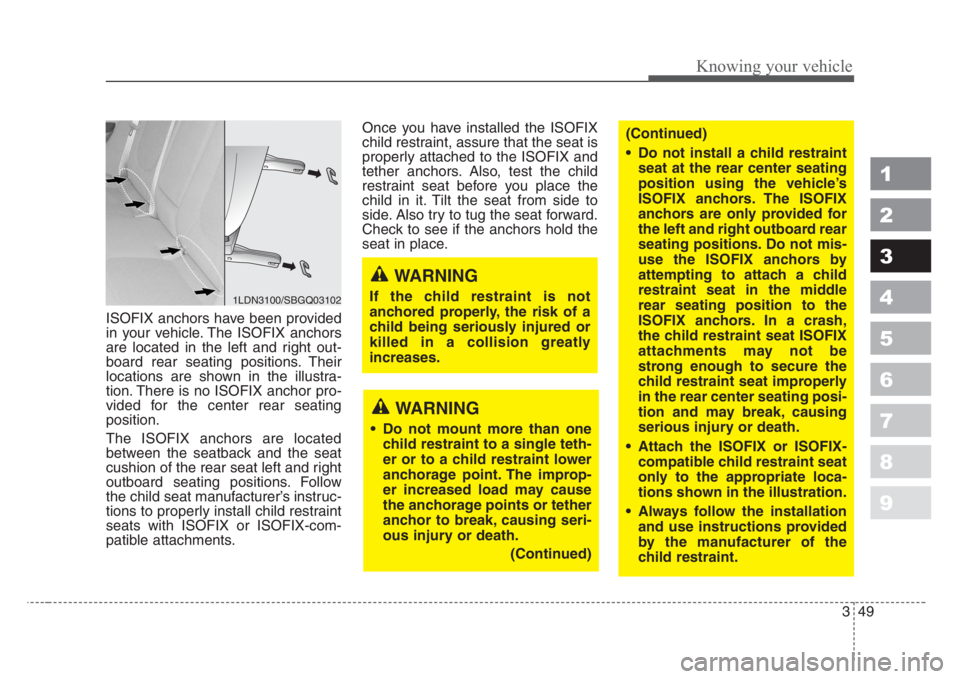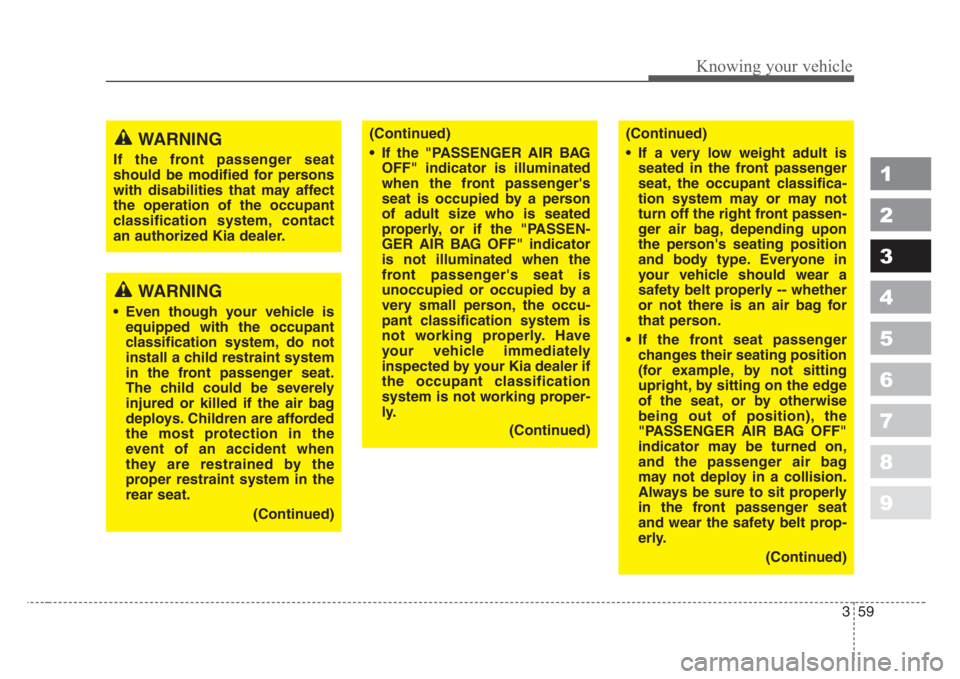2008 KIA SPECTRA5 warning
[x] Cancel search: warningPage 58 of 298

Knowing your vehicle
48 3
1
2
3
4
5
6
7
8
9
Child seat lower anchors
Some child seat manufacturers
make child restraint seats that are
labeled as International Standards
Organization Fixed (ISOFIX) or
ISOFIX-compatible child restraint
seats. These seats include two rigid
or webbing mounted attachments
that connect to two ISOFIX anchors
at specific seating positions in your
vehicle. This type of child restraint
seat eliminates the need to use seat
belts to attach the child seat in the
rear seats.There is a symbol located on the
lower portion of each side of the rear
seatbacks. These symbols indicate
the position of the lower anchors for
child restraints so equipped.
1LDN30501LDN3100/1LDN3100A
Child lower anchor
LabelWARNING
When using the vehicle's
"ISOFIX" system to install a
child restraint system in the rear
seat, all unused vehicle rear
seat belt metal latch plates or
tabs must be latched securely in
their seat belt buckles and the
seat belt webbing must be
retracted behind the child
restraint to prevent the child
from reaching and taking hold
of unretracted seat belts.
Unlatched metal latch plates or
tabs may allow the child to
reach the unretracted seat belts
which may result in strangula-
tion and a serious injury or
death to the child in the child
restraint.
Page 59 of 298

349
1
2
3
4
5
6
7
8
9
Knowing your vehicle
ISOFIX anchors have been provided
in your vehicle. The ISOFIX anchors
are located in the left and right out-
board rear seating positions. Their
locations are shown in the illustra-
tion. There is no ISOFIX anchor pro-
vided for the center rear seating
position.
The ISOFIX anchors are located
between the seatback and the seat
cushion of the rear seat left and right
outboard seating positions. Follow
the child seat manufacturer’s instruc-
tions to properly install child restraint
seats with ISOFIX or ISOFIX-com-
patible attachments.Once you have installed the ISOFIX
child restraint, assure that the seat is
properly attached to the ISOFIX and
tether anchors. Also, test the child
restraint seat before you place the
child in it. Tilt the seat from side to
side. Also try to tug the seat forward.
Check to see if the anchors hold the
seat in place.
WARNING
If the child restraint is not
anchored properly, the risk of a
child being seriously injured or
killed in a collision greatly
increases.1LDN3100/SBGQ03102
WARNING
• Do not mount more than one
child restraint to a single teth-
er or to a child restraint lower
anchorage point. The improp-
er increased load may cause
the anchorage points or tether
anchor to break, causing seri-
ous injury or death.
(Continued)
(Continued)
• Do not install a child restraint
seat at the rear center seating
position using the vehicle’s
ISOFIX anchors. The ISOFIX
anchors are only provided for
the left and right outboard rear
seating positions. Do not mis-
use the ISOFIX anchors by
attempting to attach a child
restraint seat in the middle
rear seating position to the
ISOFIX anchors. In a crash,
the child restraint seat ISOFIX
attachments may not be
strong enough to secure the
child restraint seat improperly
in the rear center seating posi-
tion and may break, causing
serious injury or death.
• Attach the ISOFIX or ISOFIX-
compatible child restraint seat
only to the appropriate loca-
tions shown in the illustration.
•Always follow the installation
and use ins
tructions provided
by the manufacturer of the
child restraint.
Page 62 of 298

Knowing your vehicle
52 3
1
2
3
4
5
6
7
8
9
WARNING- Air bags &
safety belts
• Even in vehicles with air bags,
you and your passengers
must always wear the safety
belts provided in order to min-
imize the risk and severity of
injury in the event of a colli-
sion or rollover.
•Always wear your safety belt.
It can help keep you away
from the air bags during heavy
braking just before a collision.
It may also reduce the risk of
occupant ejection.
• If occupants are not wearing
safety belts or correctly seat-
ed, they cannot be protected,
and thus face serious injury or
death.
(Continued)(Continued)
• Driver’s and front passenger’s
air bag are designed to inflate
only in certain frontal colli-
sions, and side and curtain air
bags (if equipped) are
designed to inflate in certain
side impacts. Frontal air bag
will generally not provide pro-
tection in side impacts (vehi-
cles not equipped with side
and curtain air bags) or rear
impacts, rollovers,less severe
frontal collisions. They will not
provide protection from later
impacts in a multi-impact col-
lision.
(Continued)(Continued)
• If your vehicle has been sub-
jected to flood conditions (e.g.
soaked carpeting/standing
water on the floor of the vehi-
cle, etc.) or if your vehicle has
become flood damaged in any
way, do not attempt to start
the vehicle or put the key in
the ignition before discon-
necting the battery.
Disregarding this precaution
may cause air bag deploy-
ment, which could result in
serious personal injury or
death. If your vehicle is sub-
jected to flooded conditions,
before starting the vehicle,
have the vehicle towed to an
authorized Kia dealer for
inspection and necessary
repairs.
Page 64 of 298

Knowing your vehicle
54 3
1
2
3
4
5
6
7
8
9
CAUTION
If the seat position sensor is not
working properly, the SRS air
bag warning light ( ) on the
instrument panel will illuminate
even if there is no malfunction
of the SRS air bag system,
because the SRS air bag warn-
ing light is connected with the
seat position sensor. If the SRS
air bag warning light does not
illuminate when the ignition key
is turned to the "ON" position, if
it remains illuminated after
blinking for approximately 6
seconds, or if it illuminates
while the vehicle is being driv-
en, have an authorized Kia deal-
er inspect the seat position sen-
sor and the advanced SRS air
bag system as soon as possi-
ble.
WARNING
• Modification to the seat struc-
ture can adversely affect the
seat position sensor and
cause the air bag to deploy at
a different level than should
be provided.
• Failure to properly wear safety
belts can increase the risk or
severity of injury by causing
the air bags to deploy at a dif-
ferent level than should be
provided.
• Do not place any objects
underneath the front seats
which could damage the seat
position sensor or interfere
with the occupant classifica-
tion system.
• Do not place any objects that
may cause magnetic fields
near the front seat. These may
cause a malfunction of the
seat position sensor.
(Continued)
(Continued)
• Ignoring the SRS indicator
light (air bag indicator and
passenger air bag off indica-
tor) can result in serious or
fatal injury if the air bags
occupant classification sys-
tem or pretensioners do not
work properly. Have your car
checked by a dealer as soon
as possible if the SRS warning
light alerts you to a potential
problem.
• Sitting improperly or out of
position can result in serious
or fatal injury in a crash. All
occupants should sit upright
in their seats with their feet on
the floor until the vehicle is
parked and the ignition key is
removed.
Page 65 of 298

355
1
2
3
4
5
6
7
8
9
Knowing your vehicle
Driver’s air bag
The driver’s air bag is stored in the
center of the steering wheel.
Front passenger’s air bag
Front passenger’s air bag is stored in
the instrument panel on the glove
box.
Since you cannot anticipate which air
bags will deploy or from what direc-
tion, never put any objects or orna-
ments on the instrument panel.
WARNING
• You must always sit as far
back from the steering wheel
air bag as possible (chest at
least 250 mm (10 inches) away
from the steering wheel), while
still maintaining a comfortable
seating position for good
vehicle control, in order to
reduce the risk of injury or
death in a collision.
• Never place objects over the
air bag storage compartments
or between the air bags and
yourself. Due to the speed and
force of the air bag inflation,
such objects could hit your
body at high speed and cause
severe bodily injury and even
death.
• Do not put stickers or orna-
ments on the steering wheel
cover. These may interfere
with the deployment of the air
bag.
HLZ2120
OLD0260481LDA2049
HLZ2121
Page 67 of 298

357
1
2
3
4
5
6
7
8
9
Knowing your vehicle
Always be sure that you and all vehi-
cle occupants are seated and
restrained properly (sitting upright
with the seat in an upright position,
centered on the seat cushion, with
the person's legs comfortably
extended, feet on the floor, and wear-
ing the safety belt properly) for the
most effective protection by the air
bag and the safety belt.
• The OCS may not function proper-
ly if the passenger takes actions
which can defeat the detection sys-
tem. These include:
(1) Failing to sit in an upright posi-
tion.
(2) Leaning against the door or cen-
ter console.
(3) Sitting towards the sides or the
front of the seat.
(4) Putting legs on the dashboard or
resting them on other locations
which reduce the passenger
weight on the front seat.
(5) Improperly wearing the safety
belt.
(6) Reclining the seat back.• The “PASSENGER AIR BAG OFF”
indicator illuminates after the igni-
tion key is turned to the “ON” posi-
tion or after the engine is started. If
the front passenger's seat is occu-
pied by a very small person or is
occupied by someone who is
improperly seated, the “PASSEN-
GER AIR BAG OFF” indicator will
remain illuminated and the front
passenger air bag will not deploy in
frontal crashes. If the front passen-
ger’s seat is occupied by an adult
size person seated properly, the
“PASSENGER AIR BAG OFF” indi-
cator will turn off after approxi-
mately 4 seconds and the front
passenger's air bag will deploy in
frontal collision.
CAUTION
If the occupant classification
system is not working properly,
the air bag warning light ( ) on
the instrument panel will illumi-
nate. If there is a malfunction of
the occupant classification sys-
tem, the "PASSENGER AIR BAG
OFF" indicator will not illumi-
nate and the front passenger's
air bag will deploy in frontal
crashes even if there is child or
no occupant in the front pas-
senger’s seat. If the SRS air bag
warning light does not illumi-
nate when the ignition key is
turned to "ON" position, if it
remains illuminated after blink-
ing for approximately six sec-
onds, or if it illuminates while
the vehicle is being driven, have
an authorized Kia dealer inspect
the occupant classification sys-
tem with the SRS air bag system
as soon as possible.
Page 68 of 298

Knowing your vehicle
58 3
1
2
3
4
5
6
7
8
9
Condition and operation in the front passenger occupant
classification system
Condition detected by
the occupant classifi-
cation system
1. Adult *
1
2. Child*2or child
restraint system
3. Unoccupied Off
On
OnOff
Off
OffActivated
Deactivated
Deactivated
"PASSENGER AIR
BAG OFF" indicator
light
SRS warning lightFront passenger front
air bag Indicator/Warning light Devices
*1The system detects a person who is generally adult size as an adult, thus allowing
the passenger air bag to deploy. When a smaller adult sits in the front passenger
seat, the system may detect their body shape as that of a child, thus preventing air
bag deployment.
*
2When a larger child who has outgrown a child restraint system sits in the front pas-
senger seat, the system may recognize him/her as an adult depending on his/her
physique sitting posture, or objects in the lap of the occupant, thus permitting airbag
deployment.
CAUTION
If the "PASSENGER AIR BAG
OFF" indicator illuminates or
blinks continuously when a per-
son of adult size sits in the front
passenger's seat, it could be
because that person isn't sitting
properly in the seat. If this hap-
pens, turn the vehicle off, make
sure the seat back is not
reclined, have the passenger
center on the seat cushion, with
legs comfortably extended, and
the safety belt properly posi-
tioned. Restart the vehicle and
have the person remain in this
position long enough to allow
the system to detect the person
and activate the passenger air
bag.
Page 69 of 298

359
1
2
3
4
5
6
7
8
9
Knowing your vehicle
(Continued)
• If the "PASSENGER AIR BAG
OFF" indicator is illuminated
when the front passenger's
seat is occupied by a person
of adult size who is seated
properly, or if the "PASSEN-
GER AIR BAG OFF" indicator
is not illuminated when the
front passenger's seat is
unoccupied or occupied by a
very small person, the occu-
pant classification system is
not working properly. Have
your vehicle immediately
inspected by your Kia dealer if
the occupant classification
system is not working proper-
ly.
(Continued)(Continued)
• If a very low weight adult is
seated in the front passenger
seat, the occupant classifica-
tion system may or may not
turn off the right front passen-
ger air bag, depending upon
the person's seating position
and body type. Everyone in
your vehicle should wear a
safety belt properly -- whether
or not there is an air bag for
that person.
• If the front seat passenger
changes their seating position
(for example, by not sitting
upright, by sitting on the edge
of the seat, or by otherwise
being out of position), the
"PASSENGER AIR BAG OFF"
indicator may be turned on,
and the passenger air bag
may not deploy in a collision.
Always be sure to sit properly
in the front passenger seat
and wear the safety belt prop-
erly.
(Continued)WARNING
If the front passenger seat
should be modified for persons
with disabilities that may affect
the operation of the occupant
classification system, contact
an authorized Kia dealer.
WARNING
• Even though your vehicle is
equipped with the occupant
classification system, do not
install a child restraint system
in the front passenger seat.
The child could be severely
injured or killed if the air bag
deploys. Children are afforded
the most protection in the
event of an accident when
they are restrained by the
proper restraint system in the
rear seat.
(Continued)